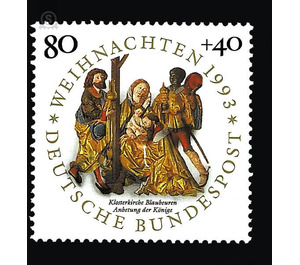Christmas - Germany / Federal Republic of Germany 1993 - 80 Pfennig
Theme: Art & Culture
| Country | Germany / Federal Republic of Germany |
| Issue Date | 1993 |
| Face Value | 80.00 |
| Color | brown white |
| Perforation | K 13 3/4 |
| Printing Type | Multicolor offset printing |
| Stamp Type | Postage stamp |
| Item Type | Stamp |
| Chronological Issue Number | 1580 |
| Chronological Chapter | GER-BRD |
| SID | 345986 |
| In 25 Wishlists | |
The Cluniac Benedictine monastery Blaubeuren near Ulm, founded in 1085, experienced a new heyday after the introduction of the Melker Reform in 1451. Soon, a new construction of the monastery and church facilities began. The long-house furnishings and the stained-glass windows fell victim to the reformation of the monastery in 1534, but the splendid furnishings of the monk's choir still convey an impressive image of that late-Gothic creative will. You will experience a crescendo of colors and shapes, which culminates in the design of the approximately 12-meter-high carved altarpiece with a double pair of wings. In this harmonious interplay, sculpture and painting merge into a total work of art of the highest perfection. On the inner wings of the retable you will find the dates of its completion in 1493 and 1494. Written news to the performers, however, have not been preserved. Stylistic peculiarities, however, clearly point to the leading Ulm carver of those years, to Michel Erhart, and his workshop. He was probably the carved holiday page and the constantly visible parts of the retable, the Retabelfuß as well as the filigree Dreiturmarchitektur the extract, handed over. This suggests that he was also responsible for the artistic conception of the whole, in the Ulm tradition of Hans Multscher (1433-1459 in Ulm active) and the suggestions of the Dutchman Nicholas Gerhaert of Leiden, the creator of the Konstanzer Hochaltarretabels (1465/66) , nachklingen. Due to other obligations of the master, the workshop of Michel Erharts was heavily involved in the execution. A handshake, especially between works of Michel Erharts and his gifted son Gregor, remains problematic in view of the pronounced group style. The paintings of the grand pianos as well as the magnificent setting of the figures and reliefs, which play a significant role in the unified overall effect of the retable, were transferred to the painter workshop of Bartholomew Zeitblom in Ulm, which, in view of the scope of the work, includes two other not known artists as well as the Memminger Bernhard Strigel added. The two weekday pages are reserved for painting. Like a picture wall, they show scenes of the Passion of Christ as well as the story of John the Baptist. In open condition, which was presented to the monks alone on public holidays, unfolds the splendor of the richly carved. Corresponding to the special veneration of the Virgin Mary in the monastery, an apocalyptic Virgin appears on the crescent moon in the center of the shrine which shelters five figures, a depiction referring to the Immaculate Conception and thus to the purity of Mary. Mary carries the Son of God, the Redeemer, in her arms, whom she offers to the believer for contemplative meditation. Three angels hold the sign of their glory, the heavenly crown, over their heads. The reliefs on the inside of the wings are dedicated to individual scenes from the life of Mary. They show Nativity and Adoration of the Magi. Although they are scenic representations, the narrative element recedes in their design. Solemn silence emanates from the figures that remain in worship and reveals the significance of the event. While wondering and overpowering determine Joseph and the Magi, Mary in her attitude and sign language becomes a symbol of humble love. The observers, that is, the Blaubeurer monks, were invited to devotional meditation and discipleship with this presentation. (Text: Petra Dietz M.A., Bonn)


